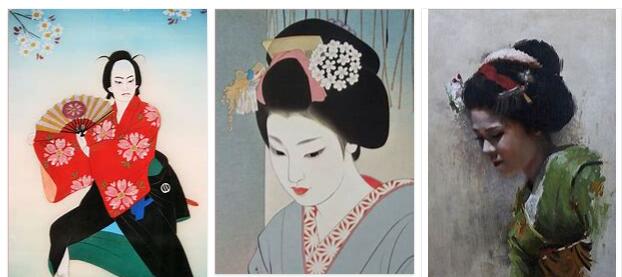To understand the current situation of Japanese art, it is necessary to briefly retrace the history of Japanese art from the point of view of its encounter with Western thought and art. In fact, the artistic tradition of Japan has a completely different original character from the European one.
The first contact between the two traditions occurs in the Momoyama era (beginning of the 17th century) with the introduction of Christian culture in Japan. At the same time, a current of thought based on the positivism of the natural sciences also appears in Japanese culture, which in the artistic manifestations is influenced by the paintings of religious subjects introduced by Christian missionaries. This meeting of the two traditions, however, is held back by the repressions of feudalism: the Tokugawa government forbids Christian expansion (in 1639) and this means that this historical period ends in less than thirty years.
Despite the persecution of Christianity, the city of Nagasaki represents a crack through which an extremely thin thread continues to unite the Japan to Europe. In the European Renaissance a scientific approach to perspective and chiaroscuro was established: in Japan the artists Gennai Hiraga (1726-1779), Kôkan Shiba (1749-1818), Kazan Watanabe (1793-1841) and finally the famous Hokusai (1760-1849), author of Ukiyoe prints. These artists discovered modern art in European culture and became its precursors when Japan, following the great Meiji reform, opened its borders to the outside world; many painters then made every possible effort to try to make European technique and thought their own.
From this period until today, the traditional arts of Japan have not died out due to Europeanization, but they continue to be very much alive and the two traditions coexist, thus constituting a singular phenomenon that is not found in other countries.
With the Meiji reform, a great process of renewal involves all sectors of Japanese culture, society and politics. This innovative wave also touches the fine arts. Looking at contemporary European art, Japan finds himself in the position of having to rapidly assimilate about fifty years: this is therefore a period of great ferment. The traditional thought of Japanese art has a difficult way to go to approach the Western art of the last period of Impressionism and the various successive currents. They absorbed European academic naturalism more Yuichi Takahashi (1828-1894) and Chû Asai (1856-1907), while they were followers of impressionism Seiki Kuroda (1866-1924) and Takeji Fujishima (1867-1943) with works that deserve the utmost consideration . Numerous groups of sculptors and painters are formed separately and gradually organize themselves by exhibiting in national and trendy exhibitions. Each of these groups represents one of the new avant-garde currents, Fauvism, Cubism, Expressionism, whose language they show to have completely absorbed.
With the end of the Meiji era and the beginning of the Taishô era (1912-25) there is a new democratic-social atmosphere, which gives life, before the Second World War, to the golden age of modern Japanese arts. The major exponents of this period are: Ryûsei Kishida (1891-1929), Narashige Koide (1887-1931), Tetsugoro Yorozu (1885-1927) and the sculptor Kôtaro Takamura (1883-1956).
After the Meiji era there is a rapid increase of capitalism, accompanied by the birth of anarchism whose ideology has an inciting influence on the development of a proletarian art. The new doctrine was baptized by traditionalist painters Usen Ogawa (1868-1938), Hyakusui Hirafuku (1877-1933) and the prematurely deceased Shoji Sekine (1899-1919) revealing a completely new world in modern Japanese art. A new ideal of individuality and freedom is affirmed in the Taishô era. In the year 12 of that period (1923) the “great earthquake” hit the Kanto region. Meanwhile, the end of the Taishô era is approaching. One after another the different currents of Western art multiply and evolve. The anti-naturalism of École de Paris becomes the model of the new generation. The artists Yuzo Saeki (1898-1928), Kanji Maeda (1896-1930), Katsuzo Satomi (born in 1895), after their return from a period of study in Paris, founded the 1930 nen Kyokai (Company of 1930). They follow the path indicated by Vlaminck, Derain and Dufy. The 1930 NEN Kyokai held five exhibitions and melts, but later the group gives rise to the new company Dokuritsu Bijutsu Kyokai (independent artistic company) holding his first exhibition in 1931 and continues its activities to date. The painters of the aforementioned group, representing Japanese Fauvism, acquired their knowledge, working hard, in Paris where H. Matisse, P. Picasso and Japan Rouault worked in the decade 1920-30. In any case, it was extremely easy for the Japanese to make the poetics of Fauvism their own, however affirming themselves with their own pictorial characteristics.
According to INSIDEWATCH.NET, the great earthquake that struck the Kanto region caused, both spiritually and economically, a shock in the Japanese people of a gravity hardly imaginable, destroying the idyllic idealism and individual respect that had hitherto existed. In the difficult Showa period (1926 ff.), The world economic depression and the rampant corruption brought together, little by little, to the rise of fascism. The fine arts gradually degenerated. The climax of Japanese Fauvism came as a result of the wave of renewal, in the post-Meiji period, that is, in the decade 1930-40, immediately before the Sino-Japanese War, the Second World War and the birth of fascism. The best known artists of this era are: Ryuzaburo Umehara (born in 1888), Sôtaro Yasui (1888-1955), Tsuguji Fujita (1886-1968), Hanjiro Sakamoto (1882-1969). The anarchism of Mavo whose art takes its name from the collage technique. Japanese surrealism is born, whose allegories seem to symbolically and psychologically express the resounding of the approaching steps of militarism and fascism. The works of the best artists should be mentioned: Ichiro Fukuzawa (born in 1898), Harue Koga (1895-1933), Kôtaro Migishi (1903-1934) and in particular those of the artists who disappeared at a young age Ai-Mitsu (1907-1946) , Misao Iida (1908-1936) and Noboru Kitawaki (1901-1951). In this period there is not an artist in Japan who did not pass directly from Dadaism to Surrealism.
